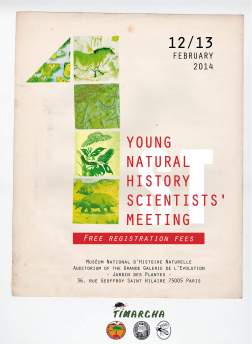Every museum has its moment of magic. In New York and Washington, exhibits came to life thanks to an ancient Egyptian tablet. In London, the mummy of Imhotep was resurrected in the halls of the British Museum. But next month in Paris, you will not need ancient sorcery to get under the spell of science: the Association for Students and Young Researchers (BDEM) at the French Museum of Natural History is organizing its 1st Young Natural History Scientists’ Meeting (12-14th February 2014)!
The museum itself is one of the biggest and oldest Natural History Museums in the world: officially founded during the French revolution, the origins of the main site (the Jardin des plantes (Botanical Gardens)) date back even further. Not surprisingly, during the course of more than two centuries the museum has amassed a lot of material (68 million(!) specimens, including some originals collected by Lamarck, Buffon and Georges Cuvier). Some of this material can be seen in the different exposition halls at the Jardin des Plantes site, others (such as the original specimens used to describe a given species) are conserved in the collection rooms, where they can be visited and studied by scientists. In addition to its function as a museum, the MNHN is also a hub for research, and has a PhD programme where students from all continents focus on diverse research topics from paleontology, ecology and evolution to conservation biology. It is these young researchers who are organizing this years meeting.
It’s a meeting for students by students, covering a whole range of disciplines, from planetary sciences to biodiversity and systematics, anatomy and evolution. And while it’s the first international version of the meeting, it emerges from almost two decades of yearly internal get-togethers. As Pierre Gueriau, one of the organizers, explained, they decided to open the meeting to a broader audience to enable more networking and discussion with colleagues, and also, because they felt that “natural history – the science aiming to describe nature – is more and more forgotten since the recent emergence of new techniques such as, for example, […] molecular phylogenies instead of morphological phylogenies. The meeting aims to show that Natural History is not a “dusty” field of research, but still includes highly dynamic scientific disciplines.” What could be a better location to “restore the reputation of and interest in natural history” than one of the world’s first Natural History Museums?

The Natural History Museum (main building, left) in Paris, including its “Grand Gallery of Evolution” (right) attracts millions of visitors each year. However, the museum is also the site of active research – and the 1st Young Natural History Scientists Meeting, organised by students for students. Pictures (Parisian Sky by Neal Sanche and The Secret Lair of Jules Verne by Trey Ratcliff) via flicker.
Moreover, not only the science of natural history, but also the buildings are of the museum are not as antiquated as one might think. The MNHN has been undergoing going some large-scale restoration work since 2000, and newly renovated buildings are gradually being opened to the public again. For example, the huge herbarium (the biggest in the world with 8 million specimens) of the Museum has just been inaugurated after 4 years of work, and the reopening of the “Parc zoologique de Paris” (zoological park) in Vincennes will be in spring 2014.
Having established that the setting for the conference is perfect – what about the meeting itself? Well, very much in the spirit of a student meeting, the focus is on student presentations and an interactive atmosphere. Each of the 4 session will include a keynote speaker, primarily from the MNHN, and all remaining slots will be filled with student talks selected from the abstracts. For those who cannot be selected for talks there will be an evening poster session where they can present their work. As a special add-on, the conference will close with excursions, where participants can get a behind-the-scenes look at otherwise inaccessible or rarely accessible collections and rooms, including the Prehistoric Collections, the newly renovated Herbarium, the taxidermy workshops and the comparative anatomy rooms. What’s more, also very much in the spirit of a student meeting (and student financials) the organisers show that you don’t need a lot of money for such a conference: registration to the meeting is FREE, and includes the full conference package, as well as coffee/tea breaks.They even offer accommodation (“Why not try couchsurfing? […H]osted by a local participant or organiser ( a few beds available, please send your inquiries”). The money for the conference comes mainly from the MNHN, the «Amis du Museum» (= Museum’s friends) and some fundraising events during the last year. If the meeting is successful, the organisers plan to get some sponsors for the next meeting, which – they hope – might allow them to partially cover the travel expenses of participants. Until then, they recommend that participants combine conference attendance with a visit to the collections, where they can look directly at specimens that are relevant for their research – and which is therefore often subsidized as a research expense.

There are amazing items on display at the Natural History Museum – from butterflies to skulls to two-headed “monsters”. Just imagine what’s behind the scenes? Pictures (by Quinn Comendant, Lo,Lola, Lorraine and Istolethetv) via flickr.
So, after half a year of organisation, there is one more week left for conference registration (deadline is Jan 19, 2014) and another month until the meeting kicks off. I’m keeping my fingers crossed for everything to work out as well as it was planned, and that the time is right for an internal meeting to step up on the international stage!
——————————————————————————————————–
This is my second post about a science event organised by students for students (you can read about the first one here). I’d love to cover more, so if you are organising one or know someone who’s organising one, please feel free to contact me!

